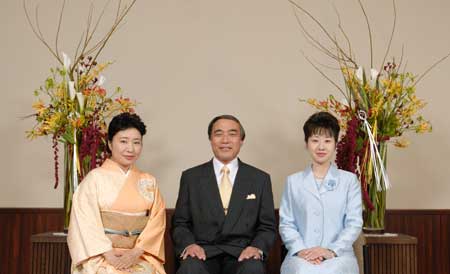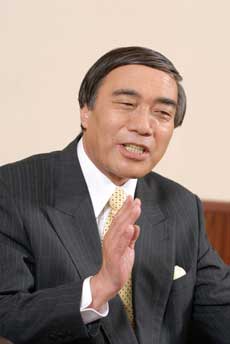2007 New Year Round-Table Talk
Cultivating the Shinagawa of Tomorrow
This year, Shinagawa residents who are learned professionals in the field of fine arts, such as painting and music, were invited to talk with Mayor Takeshi Hamano about future Shinagawa city planning, with regard to education, child-raising, the growing elderly population and the environment.

Introduction of a Nine-Year Program for Elementary through Junior High School, and the Future of Education in Shinagawa City
Mayor: We started our nine-year continuous education program from elementary through junior high school this fiscal year. Last autumn, I believe the two of you came to the Culture Festival of Hino Gakuen. Let me ask you, what was your impression of the school?
Ms. Nemoto: I was able to watch the chorus competition. It was really encouraging to see students with such lively, cheerful faces. I think trying to create a piece of music with your friends would be a great experience.
Ms. Toriyama: I went to the “ikebana” flower arrangement exhibit. It was refreshing to see that children are into club activities involving traditional Japanese arts. I think it’s important that children have an opportunity to have hands-on experience with Japanese culture.
Mayor: The nine-year unified elementary through junior high school education program was implemented with the aim of providing an education system that is more enriching and attractive for students. In junior high school, education begins on the premise that certain skills and knowledge were naturally learned during elementary school, but sometimes, there are children who still do not thoroughly understand what was covered in elementary school. This continuous education system fills in the gap generated from the separate elementary and junior high school education.
Ms. Nemoto: I think that in order to make the best use of a great curriculum and facilities, it is necessary to have good teachers and an environment that encourages children to make good friends.
Mayor: Shinagawa City is considering to discuss the feasibility of independently hiring teachers who love and understand Shinagawa City children, and are enthusiastic about teaching.
Child-Raising and Education Open to the Community
Ms. Nemoto: I heard that there are certain education programs that only Shinagawa City provides.
Mayor: Yes, for example, the “Shimin-ka.” This teaches children about the importance of social norms and being courteous in society, and developing a social character. We conduct programs whereby people in the neighborhood and professionals in various fields come in to talk to the children. The children seem to love having people come and talk with them.
Ms. Nemoto: When we were children, if you went to the park, there were always older boys and girls there, and all kids played together. Also, my grandmother was always around, so I was able to communicate with her in a way completely different from the way I communicate with my parents.
Ms. Toriyama: Yes, that’s right! Those kinds of opportunities are really rare these days. Such programs may lead to a new way of communicating in the local community that is actually a lost art in this day and age.
Mayor: In elementary schools in Shinagawa, there is a program called “Sumairu School.” It provides children with time to study, participate in sports, and play, after school and on Saturdays. The school and people in the community work together to support whatever activities the children like, have an interest in, or are good at and would like to pursue.
Ms. Toriyama: These days, many people live with their nuclear family and rarely have a chance to talk with people of other generations, other than their own parents. I imagine Sumairu School also plays a role in addressing this.
Friendly Exchanges that Exceed Generational Boundaries Will Foster City-Wide Activity
Mayor: I understand, Ms. Toriyama, that you are involved in a “Terakoya” school project. Please tell us what it’s like.
Ms. Toriyama: Well, this project began when people in the community put their heads together and tried to come up with something good for the children around them. We draw pictures using paints and materials used in Japanese paintings and teach children about the splendor of Japanese culture. Through the activity of painting pictures, we promote interaction.
Mayor: I understand, Ms. Nemoto, that you participated in the city resident musical in 2001 in celebration of the 400th Anniversary of Tokaido Road. What was it like?
Ms. Nemoto: Well, first of all, we practiced a lot! We were all of different ages and we came from various backgrounds. However, we were able to share the joy of putting on a performance with great team spirit. Those who participated are still in touch today.
Mayor: I see, so you weren’t competing against each other, but enjoying the gathering of people from all walks of life.
Ms. Toriyama: Yes, it really doesn’t matter whether or not you are good at music or art.
Mayor: Not only speaking in terms of art, the energy created when people of various generations gather to achieve one goal will become a vital force for the city.
 |
|
|
|
Mayor
Takeshi Hamano
|
Ms. Rei Toriyama
Shinagawa Culture Foundation Council Member. Japanese-style painting artist.
|
Ms. Keiko Nemoto
Shinagawa Culture Foundation Council Member. Musician.
|
Learning from the Elderly – The Key to Youth and Energy
Mayor: Shinagawa City is currently pouring its efforts into welfare programs for the elderly. What do you think is the key for good health in old age?
Ms. Nemoto: I play the piano and teach people how to sing in a chorus class. These people in their 60s and 70s are really enthusiastic and full of vitality. I think people who do things eagerly are very bright and cheerful.
Mayor: It seems that most people who are involved in the arts lead long, healthy lives…
Ms. Nemoto: Yes, I think so, too! Maybe because in the arts, there’s no goal, and so, it’s
like climbing a mountain that has no peak. Perhaps the key to a long life may be to always be a challenger, trying to do the unachievable.
Ms. Toriyama: Yes, and I think it’s important to have a sense of curiosity and always have an interest in all kinds of things.
Mayor: I think we can all gain strength and inspiration from elderly people who always try to do new and different things even in their old age. I hope our city administration can develop programs that support elderly people who challenge themselves.
City Planning That Embraces the Future of Shinagawa City
Mayor: Ms. Toriyama, I think the “Mottainai furoshiki” cloth that you designed for the Shinagawa-ku Shopping Avenue Federation is really unique!
Ms. Toriyama: With the movement to use the traditional “furoshiki” cloth when shopping, I provided an original design because I shared the same ideology. The “furoshiki,” which is a simple cloth that easily forms its shape to fit whatever it’s wrapped around, is a charming part of Japanese culture. I think it’s good and important to make the best use of it in our everyday lives. Plus, it’s environmentally friendly!
Mayor: I think the environment is a major factor for consideration in future city planning programs. Recently, what we’ve been pouring our efforts into is making road pavements water-retentive as a measure against urban heat island effects. Water-retentive pavements keep water in the asphalt, and the moisture acts to keep the temperature of the streets down.
Ms. Nemoto: I understand that planting greenery is also a heat island countermeasure.
Mayor: Yes. It is often said, the issue of the environment is not something we should leave for other people to deal with. I think it’s highly important for everyone to have an interest because ultimately, it’s up to each and every one of us to take action in our everyday lives.
Ms. Toriyama: I think Shinagawa City is a place where rich sensitivity is deeply rooted, and traditional Japanese culture and art are blended into everyday living, connecting people to environmental issues. I hope these kinds of programs will continue to be widely promoted in the future.
Mayor: There are a lot of things that the city administration needs to accomplish. I hope to work on them while listening to what city residents have to say, and borrowing wisdom from everyone. I hope I can continue to look forward to your support. Thank you for coming today!
Ms. Nemoto and Ms. Toriyama: Thank you, Mayor!
|



